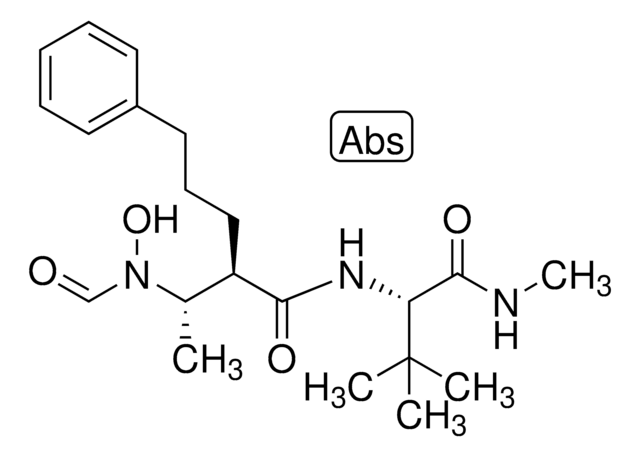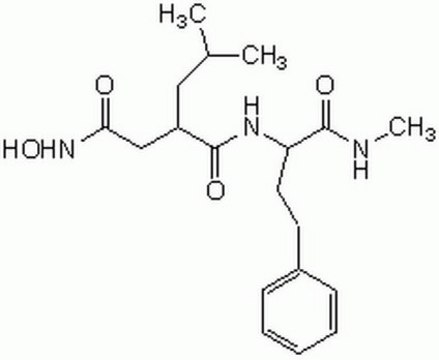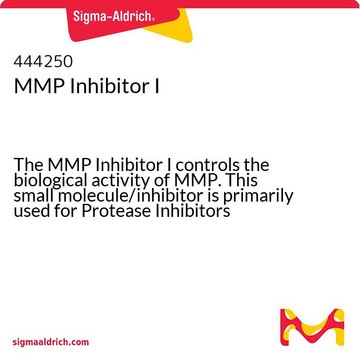推荐产品
一般描述
专属性:GM6001 MMP抑制剂,也称为Ilomastat或N-[(2R)-2-(羟酰胺羰基甲基)-4-甲基戊酰基]-L-色氨酸甲酰胺,是一种有效的胶原酶抑制剂。分子量:388.47
报告的Ki值如下(参见Galardy Ref):
人MMP-1(成纤维细胞胶原酶):0.4 nM
人MMP-3(基质溶酶):27 nM
人MMP-2(72 kDa明胶酶):0.5 nM
人MMP-8(中性粒细胞胶原酶):0.1 nM
人MMP-9(92 kDa明胶酶):0.2 nM
用于培养细胞的典型工作稀释液为10-25 μM。{1mg/ml DMSO溶液等于2.57 mM}。 GM6001将从超过100μM的水溶液中沉淀出来。应使用低盐缓冲液进行水性稀释,以防止GM6001从溶液中沉淀(推荐的稀释缓冲液:50 mM Tris pH7.5,150 mM NaCl和20 mM CaCl2.2H20)。建议在稀释后测定工作水溶液中GM6001的浓度,并在每次使用前确认。 其他申请信息:
体内
GM6001在动物的典型剂量为50-100 mg/kg体重。一般每天或隔日IP给药。 由于研究表明它在MS模型中具有疗效,因此认为它可以穿过血脑屏障。
如果由I.V.动物体内的半衰期约为一个小时,因此必须经常给药。因此,优选的方法是通过腹膜内递送药物作为在水或盐水中的混悬液。半衰期没有变化,但由于其在动物′系统中的溶解缓慢,因此给药频率不高。它必须每隔一天左右再递送一次。它也可以在盐水混悬液中皮下递送。 该药物会像肿块一样沉淀在组织内,但令人惊讶的是,它确实进入了动物系统才有效。
溶解度
在DMSO中可溶至至少400 mg/mL。然后可以将其在水中稀释,并且必须非常快速地混合以避免沉淀。
稳定性
GM6001的浓度为1 mM(首选0.1 mM)时,在4°C下以每月1%的速度分解。在37°C时,每天增加至1%。在-20°C时,它相当稳定,作为固体,建议非常稳定的
建议低盐缓冲液作为稀释剂,以减少沉淀。稀释的溶液切勿冷冻。
应通过280 nm处的吸光度定期测定储备溶液的浓度。
报告的Ki值如下(参见Galardy Ref):
人MMP-1(成纤维细胞胶原酶):0.4 nM
人MMP-3(基质溶酶):27 nM
人MMP-2(72 kDa明胶酶):0.5 nM
人MMP-8(中性粒细胞胶原酶):0.1 nM
人MMP-9(92 kDa明胶酶):0.2 nM
用于培养细胞的典型工作稀释液为10-25 μM。{1mg/ml DMSO溶液等于2.57 mM}。 GM6001将从超过100μM的水溶液中沉淀出来。应使用低盐缓冲液进行水性稀释,以防止GM6001从溶液中沉淀(推荐的稀释缓冲液:50 mM Tris pH7.5,150 mM NaCl和20 mM CaCl2.2H20)。建议在稀释后测定工作水溶液中GM6001的浓度,并在每次使用前确认。 其他申请信息:
体内
GM6001在动物的典型剂量为50-100 mg/kg体重。一般每天或隔日IP给药。 由于研究表明它在MS模型中具有疗效,因此认为它可以穿过血脑屏障。
如果由I.V.动物体内的半衰期约为一个小时,因此必须经常给药。因此,优选的方法是通过腹膜内递送药物作为在水或盐水中的混悬液。半衰期没有变化,但由于其在动物′系统中的溶解缓慢,因此给药频率不高。它必须每隔一天左右再递送一次。它也可以在盐水混悬液中皮下递送。 该药物会像肿块一样沉淀在组织内,但令人惊讶的是,它确实进入了动物系统才有效。
溶解度
在DMSO中可溶至至少400 mg/mL。然后可以将其在水中稀释,并且必须非常快速地混合以避免沉淀。
稳定性
GM6001的浓度为1 mM(首选0.1 mM)时,在4°C下以每月1%的速度分解。在37°C时,每天增加至1%。在-20°C时,它相当稳定,作为固体,建议非常稳定的
建议低盐缓冲液作为稀释剂,以减少沉淀。稀释的溶液切勿冷冻。
应通过280 nm处的吸光度定期测定储备溶液的浓度。
应用
GM6001 MMP抑制剂粉末控制MMP的生物学活性。这种小分子/抑制剂主要用于生化试剂的应用。
生化/生理作用
抑制剂种类:蛋白质酶抑制剂
蛋白质靶标:间质胶原酶
外形
一些批次在水合后会变成棕色;棕色不影响抑制能力;在溶液中GM6001的范围从透明到棕色
冻干后,在DMSO(1-5 mg/ml)中复溶。也使用过其他有机溶剂(乙醇)(Galardy et al., 1994)。
储存及稳定性
自收到之日起,以冻干形式在2-8º C下可最多保存1年。 如果在DMSO中进行复溶,则材料可溶至至少400mg /mL,建议在-20 º C下以可用的等份保存,避免重复冷冻/解冻循环。如果在水溶液中复溶,请在2-8º C未稀释的等分液中短期保存。详情参见稳定性信息。
法律信息
CHEMICON is a registered trademark of Merck KGaA, Darmstadt, Germany
免责声明
除非我们的产品目录或产品附带的其他公司文档另有说明,否则我们的产品仅供研究使用,不得用于任何其他目的,包括但不限于未经授权的商业用途、体外诊断用途、离体或体内治疗用途或任何类型的消费或应用于人类或动物。
储存分类代码
11 - Combustible Solids
WGK
WGK 3
闪点(°F)
Not applicable
闪点(°C)
Not applicable
Sean E Gill et al.
Developmental biology, 261(2), 313-323 (2003-09-23)
Tissue inhibitors of metalloproteinases (TIMPs) regulate extracellular matrix (ECM) degradation by matrix metalloproteinases (MMPs). We have examined the role of TIMP-3 on ECM homeostasis and bronchiole branching morphogenesis during murine embryogenesis. Employing an in vitro organ culture system, we found
D E Levy et al.
Journal of medicinal chemistry, 41(2), 199-223 (1998-02-11)
Modifications around the dipeptide-mimetic core of a hydroxamic acid based matrix metalloproteinase inhibitor were studied. These variations incorporated a variety of natural, unnatural, and synthetic amino acids in addition to modifications of the P1' and P3' substituents. The results of
Joseph F Porter et al.
Breast cancer research and treatment, 94(2), 185-193 (2005-09-06)
Tissue inhibitor of metalloproteinases-1 (TIMP-1) is a widely expressed, secreted protein that functions primarily to inhibit members of a large family of metalloproteinases (MPs). Because of the ability of TIMP-1 to inhibit MPs, it functions in many of the same
Low molecular weight inhibitors in corneal ulceration.
R E Galardy et al.
Annals of the New York Academy of Sciences, 732, 315-323 (1994-09-06)
Matthias P Lutolf et al.
Nature biotechnology, 21(5), 513-518 (2003-04-22)
We have engineered synthetic poly(ethylene glycol) (PEG)-based hydrogels as cell-ingrowth matrices for in situ bone regeneration. These networks contain a combination of pendant oligopeptide ligands for cell adhesion (RGDSP) and substrates for matrix metalloproteinase (MMP) as linkers between PEG chains.
我们的科学家团队拥有各种研究领域经验,包括生命科学、材料科学、化学合成、色谱、分析及许多其他领域.
联系技术服务部门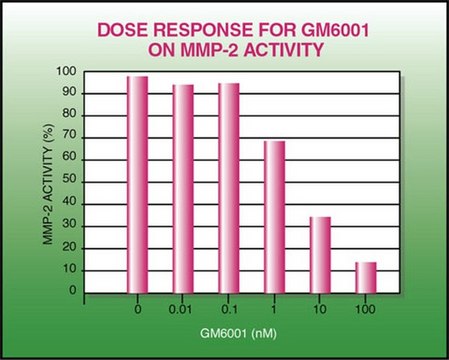
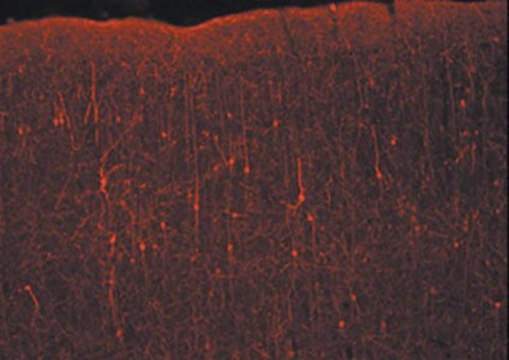
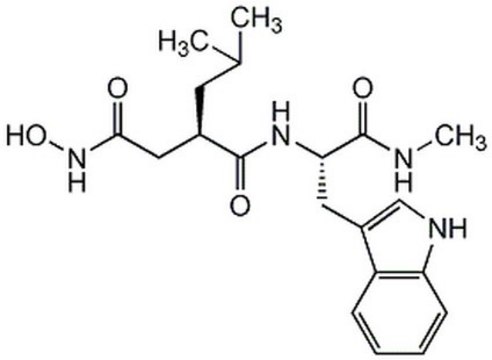
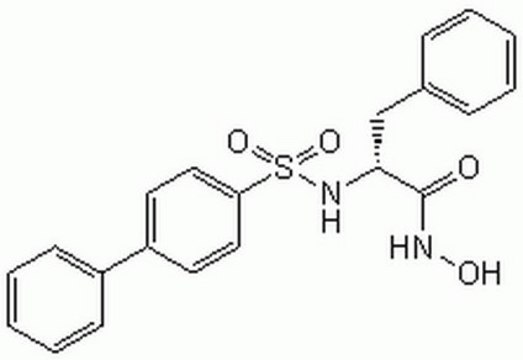
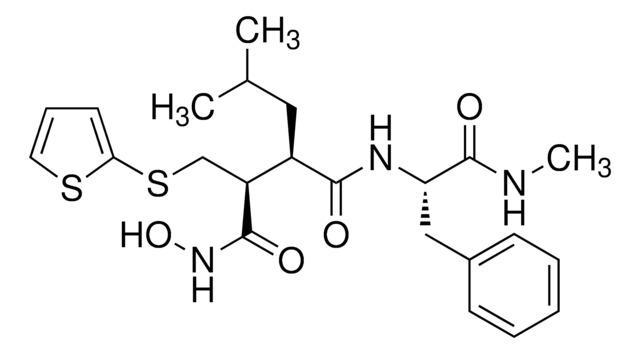
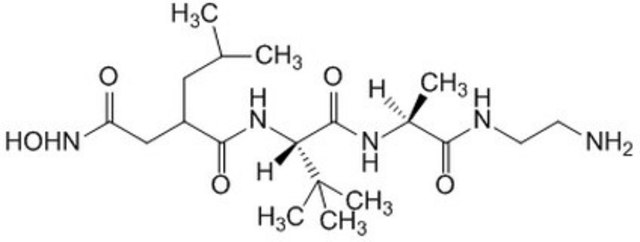
![(R)-N4-Hydroxy-N1-[(S)-2-(1H-indol-3-yl)-1-methylcarbamoyl-ethyl]-2-isobutyl-succinamide >95% (HPLC)](/deepweb/assets/sigmaaldrich/product/structures/381/824/43d65d68-be23-4584-80e5-31662c7f8f4a/640/43d65d68-be23-4584-80e5-31662c7f8f4a.png)
